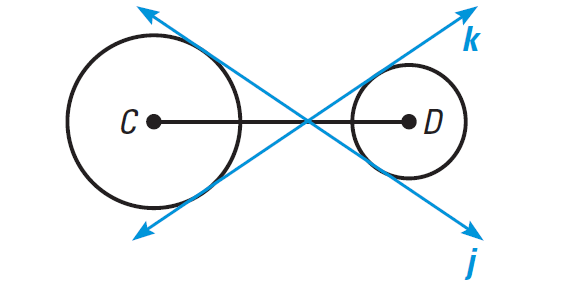TANGENTS TO CIRCLES WORKSHEET
Problem 1 :
Tell which line or segment is best described as a tangent in the diagram shown below.

Problem 2 :
In the diagram shown below, tell whether the common tangents are internal or external.

Problem 3 :
In the diagram shown below, tell whether the common tangents are internal or external.

Problem 4 :
In the diagram shown below, describe all common tangent and identify the point of tangency.

Problem 5 :
In the diagram shown below, say whether EF is tangent to the circle with center at D.

Problem 6 :
In the diagram shown below, I am standing at C, 8 feet from a grain silo. The distance from me to a point of tangency is 16 feet. What is the radius of the silo ?

Problem 7 :
In the diagram shown below,
SR is tangent at R to the circle with center P
ST is tangent at T to the circle with center P
Prove : SR ≅ ST

Problem 8 :
In the diagram shown below,
AB is tangent at B to the circle with center at C
AD is tangent at D to the circle with center at C
Find the value of x.


Answers
Problem 1 :
Tell which line or segment is best described as a tangent in the diagram shown below.

Answer :
EG is a tangent, because it intersects the circle in one point.
Problem 2 :
In the diagram shown below, tell whether the common tangents are internal or external.

Answer :
The lines j and k intersect CD, they are common internal tangents.
Problem 3 :
In the diagram shown below, tell whether the common tangents are internal or external.

Answer :
The lines m and n do not intersect AB, so they are common external tangents.
Problem 4 :
In the diagram shown below, describe all common tangent and identify the point of tangency.

Answer :
The vertical line x = 8 is the only common tangent of the two circles.
The point of tangency is (8, 4).
Note :
The point at which a tangent line intersects the circle to which it is tangent is the point of tangency.
Problem 5 :
In the diagram shown below, say whether EF is tangent to the circle with center at D.

Answer :
We can use the Converse of the Pythagorean Theorem to say whether EF is tangent to circle with center at D.
Because 112 + 602 = 612, ΔDEF is a right triangle and DE is perpendicular to EF.
So by Theorem 2, EF is tangent to the circle with center at D.
Problem 6 :
In the diagram shown below, I am standing at C, 8 feet from a grain silo. The distance from me to a point of tangency is 16 feet. What is the radius of the silo ?

Answer :
By the Theorem 1, tangent BC is perpendicular to radius AB at B. So ΔABC is a right triangle. So we can use the Pythagorean theorem.
Pythagorean Theorem :
(r + 8)2 = r2 + 162
Square of binomial :
r2 + 16r + 64 = r2 + 256
Subtract r2 from each side :
16r + 64 = 256
Subtract 64 from each side :
16r = 192
Divide each side by 16.
r = 12
Hence, the radius of the silo is 12 feet.
Problem 7 :
In the diagram shown below,
SR is tangent at R to the circle with center P
ST is tangent at T to the circle with center P
Prove : SR ≅ ST

Answer :

Problem 8 :
In the diagram shown below,
AB is tangent at B to the circle with center at C
AD is tangent at D to the circle with center at C
Find the value of x.

Answer :
By the Theorem 3, two tangent segments from the same point are congruent.
AB = AD
Substitute :
x2 + 2 = 11
Subtract 2 from each side.
x2 = 9
Take square root on each side.
x = ± 3
Hence, the value of x is 3 or -3.
Kindly mail your feedback to v4formath@gmail.com
We always appreciate your feedback.
©All rights reserved. onlinemath4all.com
Recent Articles
-
AP Calculus AB Problems with Solutions (Part - 19)
Apr 24, 25 11:10 PM
AP Calculus AB Problems with Solutions (Part - 19) -
AP Calculus AB Problems with Solutions (Part - 18)
Apr 24, 25 11:06 PM
AP Calculus AB Problems with Solutions (Part - 18) -
Derivative of Absolute Value of x Using Limit Definition
Apr 23, 25 11:11 AM
Derivative of Absolute Value of x Using Limit Definition
